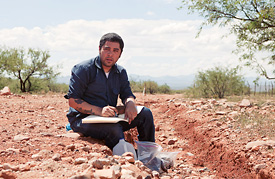For Jason De Leon, the story of undocumented migrant workers’ treacherous trek northward from Mexico through Arizona is a complex, layered contemporary narrative best told by what isn’t said, and what is left behind.
For the past four years, De Leon — an assistant professor of anthropology at U-M — has directed a group of students in an exhaustive collection and archeological documentation of clothes, personal belongings and odd bits of refuse left in the wake of undocumented migrates traveling along the U.S.-Mexico border. While De Leon’s Undocumented Migration Project (UMP) has received widespread attention in the national news media and especially in the southwest United States, the Institute of Humanities is the first venue to present the expansive collection of found objects of De Leon’s meticulous chronicle, which some critics claim offers an evocative testament to the “human cost of immigration.”

U-M researcher Jason De Leon heads the Undocumented Migration Project, which uncovers the stories behind materials discarded in the Sonora desert and recovered by his team since 2008. Photo by Michael Wells.
The exhibit, “State of Exception,” opens Thursday, and features the videography of acclaimed photographer Richard Barnes, whose work has been exhibited at many prestigious museums in the United States. Barnes’ video work, which complements De Leon’s humanistic undertaking, depicts the conditions and challenges of Mexican citizens’ journey while evoking the ambiguity of the found objects — water bottles, back packs, personal photos and wallets, forsaken shoes — that litter the desert path leading to the Arizona border.
The exhibit is part of the Understanding Race Project, the LSA theme semester that explores the many notions of race throughout the winter semester. From January through April, an extensive range of public exhibits, performances, lectures, symposia and more than 130 courses in several disciplines explore the concept and impact of race. The historical, cultural, psychological and legal interpretations of race will be examined from both national and global perspectives. Highlights of the project include the “Race: Are We So Different?” exhibit developed by the American Anthropological Association and the Science Museum of Minnesota and “IndiVisible: African-Native American Lives in the Americas,” a Smithsonian Institution Traveling Exhibit.
As evidence of the historical significance of UMP, the collected items — which are kept in an intricate inventory of boxes at De Leon’s office — are under consideration to be transferred during summer 2014 to the Smithsonian Institute Archives.
“Together, the collected found objects and Richard Barnes’ photography reveals the nuances, complexities and violence of the culture of immigration along the southeastern U.S. border,” said Amanda Krugliak, who, as exhibition curator, selected a range of items to evoke the distinct experiences of undocumented migrants. “We hope the exhibit will inspire a range of conversations, from the power of ‘found objects’ to evoke stories and profound meanings, to a new way of thinking about immigration policy.”
Opening reception for “State of Exception” will be 5:30 p.m. Thursday at the Institute of Humanities. Jason De Leon, Richard Barnes and Amanda Krugliak will be on hand for a panel discussion.

